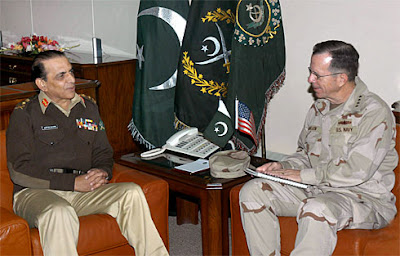


The minister of defense is a civilian member of the cabinet, chairs the Defence Council, and is in turn a member of the higher-level Cabinet Defence Committee. The Ministry of Defence has a permanent staff of civil servants headed by the defense secretary general. Of particular importance to the Ministry of Defence is the adviser for military finance, who heads the Military Finance Division in the Ministry of Finance but is attached to the Ministry of Defence. The adviser functions as the principal financial officer of the defense ministry and the subordinate services.
The Joint Chiefs of
Pakistan is a poor country riven with ethnic and religious tensions. Pakistan enjoys close ties with China and shares an antipathy and distrust of India. Half of Pakistan disappeared following its disastrous 1971 war with India.
The Pakistan Army a total strength of 520000, larger than that of the United States, with a reserve element of 500,000 who have a reserve obligation up to the age of 45 years.
Since the founding of Pakistan, the army has been key in holding the state together, promoting a feeling of nationhood among disparate peoples and providing a bastion of selfless service in the midst of a venal government system. All too frequently, the Pakistan Army has felt the need to take over the government, cleanse it of corruption and try to reform its bureaucracy before returning it to civilian control. Army control of the government has all too often led to a corrupt military regime that eventually collapsed. Currently, the army is once again in charge of the government of Pakistan.
The key holder of power in the armed forces and, along with the president and the prime minister, one of the triumvirate that runs the country is the chief of the army staff (COAS)--formerly called the commander in chief. The COAS operates from army headquarters in Rawalpindi, near Islamabad. From this position, Ayub Khan, Zia and Musharef all seized power.
Other senior staff positions, at the lieutenant general level, include a chief of general staff, who supervises army intelligence and operations; the master general of ordnance; the quartermaster general; the adjutant general; the inspector general for evaluation and training; and the military secretary. The headquarters function also includes the chief of the Corps of Engineers, the judge advocate general, and the comptroller of civilian personnel, all of whom report to the vice chief of the army staff.
The 20 Infantry & 2 Armored Divisions are grouped under 9 different Corps headquarters commanded by 3-star Lieutenant Generals. These are:
There is also the Northern Area Command, headquartered at Gilgit, directly responsible to army general headquarters.
Active army strength in 1994 was 520,000. In addition, there were 300,000 reserve personnel. Reserve status lasted for eight years after leaving active service or until age forty-five for enlisted men and age fifty for officers.
Paramilitary organizations, which were mainly of symbolic importance, included the 185,000-member National Guard, comprising the Janbaz Force--locally recruited militia mainly charged with air defense--and two programs similar to the United States Reserve Officers Training Corps, the National Cadet Corps and the Women Guard. The Women Guard, unlike the National Cadet Corps, included individuals trained in nursing, welfare, and clerical work. There were also some women in the Janbaz Force, and a very small number of women were recruited into the regular service in limited numbers to perform medical and educational work.
Paramilitary internal security forces were organized on the provincial level but were subordinate to the Ministry of Interior and were commanded by seconded army generals. These forces were in effect an extension of the army for internal security duties. The Pakistan Rangers, headquartered in Lahore, dealt with unrest in Punjab, while the Mehran Force performed similar functions in Sindh. In 1994 their strengths were 25,000 and 24,000, respectively, divided into "wings" of approximately 800 men each. The Frontier Corps, with a strength of 65,000, was based in Peshawar and Quetta with responsibility for the North-West Frontier Province and Balochistan. The corps was responsible to both the Ministry of States and Frontier Regions and to army headquarters. The corps was divided into twenty-seven local units--fourteen in the North-West Frontier Province and thirteen in Balochistan--and included the Chitral Scouts, the Khyber Rifles, the Kurram Militia, the Tochi Scouts, the South Waziristan Scouts, the Zhob Militia, and the Gilgit Scouts. There was also a Coast Guard, subordinate to the Ministry of Interior and staffed by army personnel.
In times of natural disaster, such as the great floods of 1992, army engineers, medical and logistics personnel, and the armed forces played a major role in bringing relief and supplies. The army also engaged in extensive economic activities. Most of these enterprises, such as stud and dairy farms, were for the army's own use, but others performed functions beneficial to the local civilian economy. Army factories produced such goods as sugar, fertilizer, and brass castings and sold them to civilian consumers.
Several army organizations performed functions that were important to the civilian sector across the country. For example, the National Logistics Cell was responsible for trucking food and other goods across the country; the Frontier Works Organization built the Karakoram Highway to China; and the Special Communication Organization maintained communications networks in remote parts of Pakistan.
No comments:
Post a Comment